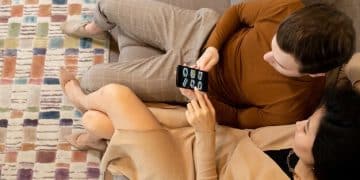Augmented Reality Shopping: Virtual Try-On Reduces Returns by 10% in US

Augmented Reality (AR) shopping, particularly through virtual try-on technology, is revolutionizing the US apparel market by enabling customers to ‘try’ clothes remotely, leading to a significant reduction in return rates, with reported decreases of up to 10%.
Imagine trying on clothes from the comfort of your home and knowing exactly how they’ll look—that’s the promise of Augmented Reality Shopping: How Virtual Try-On is Reducing Return Rates by 10% in US Apparel Market.
The Rise of Augmented Reality in Retail
Augmented Reality (AR) is no longer a futuristic fantasy; it’s a present-day reality transforming the retail landscape. With the proliferation of smartphones and increasing consumer comfort with digital experiences, retailers are leveraging AR to enhance the shopping journey.
AR offers a unique blend of the physical and digital worlds, allowing customers to interact with products in ways previously unimaginable. From virtually trying on makeup to visualizing furniture in their homes, AR is providing immersive and personalized shopping experiences.
What is Augmented Reality Shopping?
AR shopping involves overlaying digital information onto the real world through devices like smartphones or tablets. In the context of retail, this means allowing customers to “try” products before they buy, without ever stepping into a physical store.
- Virtual try-on for apparel and accessories.
- Visualizing furniture and home decor in a user’s living space.
- Interactive product demos that showcase features and benefits.
This technology enhances consumer engagement, provides detailed product information, and creates a more confident purchase decision. The benefits are mutual, as retailers experience higher customer satisfaction and reduced return rates.
In conclusion, Augmented Reality in retail is changing how consumers shop, offering unique benefits that physical stores cannot. By integrating digital content with real-world context, AR enhances buying experiences, leading to increased engagement and satisfaction.

Virtual Try-On Technology: A Game Changer for Apparel
Virtual try-on technology is at the forefront of AR’s impact on the apparel industry. By using a device’s camera, customers can see how clothes, accessories, or makeup would look on them, creating a highly personalized shopping experience.
This technology reduces the guesswork and uncertainty associated with online apparel purchases. Customers can make more informed decisions, leading to fewer returns and greater satisfaction.
How Does Virtual Try-On Work?
Virtual try-on technology uses a combination of AR, computer vision, and 3D modeling to create a realistic simulation. Here’s a simplified breakdown:
- The customer uses their device’s camera to scan their face or body.
- The technology creates a 3D model of the customer.
- Customers can select different products to ‘try’ on.
The accuracy and realism of these simulations are constantly improving, making virtual try-on an increasingly reliable tool for shoppers. This level of detail helps consumers visualize how items will look in their real-world setting.
Virtual try-on technology is transforming the apparel industry by improving customer decision-making, leading to fewer returns and greater overall satisfaction. Embracing this technology allows retailers to offer unique, personalized experiences and create stronger customer connections.
The Impact on Return Rates in the US Apparel Market
One of the most significant benefits of virtual try-on technology is its ability to drastically reduce return rates. The apparel industry has historically struggled with high return rates due to sizing issues, fit problems, and general dissatisfaction.
By allowing customers to visualize products on themselves before making a purchase, virtual try-on minimizes the chances of these issues arising. Here’s how the technology impacts return rates.
Quantifying the Reduction in Return Rates
Case analyses have demonstrated that implementing virtual try-on technology can lead to a significant reduction in return rates. Specifically, studies in the US apparel market have shown a 10% decrease in returns among retailers who actively utilize this technology
- Improved customer confidence in purchase decisions.
- Reduced instances of incorrect sizing and fit.
- Enhanced satisfaction and reduced post-purchase remorse.
These results highlight the tangible benefits of integrating AR into the shopping experience. Not only does it improve customer satisfaction, but it also has a direct impact on a retailer’s bottom line.
Virtual try-on technology demonstrates a clear potential to drastically reduce return rates in the US apparel market. With the proper implementation, retailers can see considerable improvements in consumer satisfaction and overall operational efficiency.

Consumer Behavior and Adoption of AR Shopping
Understanding consumer behavior is crucial for the successful adoption of AR shopping technologies. While the technology itself is impressive, its value ultimately depends on how consumers perceive and use it.
Several factors influence consumer adoption of AR shopping, including ease of use, perceived value, and overall shopping experience.
Driving Factors Behind AR Adoption
Ease of use plays one of the most important roles. Consumers are more likely to use AR tools if they are intuitive and require minimal effort. Other factors include:
- Perceived Value: Customers must see clear benefits, such as reduced uncertainty or enhanced convenience.
- Trust and Security: Consumers need to trust that the technology is secure and won’t compromise their privacy.
- Integration with Existing Shopping Habits: AR shopping should complement, not complicate, existing behaviors.
By addressing these factors, retailers can increase the likelihood of consumer adoption and realize the full potential of AR shopping.
The integration of AR in shopping reflects a move towards more personalized and convenient shopping experiences. Retailers will need to prioritize consumer needs and preferences, resulting in broader adoption and success.
Challenges and Considerations for Retailers
While the benefits of AR shopping are significant, retailers face several challenges when implementing these technologies. Addressing these issues is critical for successful AR adoption.
These challenges range from technical limitations to consumer concerns. To overcome hurdles, retailers must adopt comprehensive strategies.
Key Challenges in Implementing AR Shopping
Ensuring the technology is compatible with a wide range of devices is one of the main challenges. Other difficulties include:
- High Implementation Costs: The initial investment in AR technology can be substantial.
- Data Privacy Concerns: Retailers must address concerns about data collection and usage.
- Need for Continuous Improvement: AR technology is constantly evolving, requiring ongoing updates and refinements.
To overcome these challenges, retailers will need to invest in robust infrastructure, prioritize data privacy, and commit to continuous improvement.
Retailers can take full advantage of AR shopping by carefully addressing these challenges and adopting comprehensive strategies. Investing in a strong technological infrastructure and prioritizing consumer privacy are essential for successful AR implementation.
The Future of AR Shopping: Trends and Predictions
The future of AR shopping holds tremendous potential for further innovation and transformation. As technology continues to evolve, AR is expected to become even more integrated into our daily shopping habits.
Emerging trends and predictions point towards a future where AR is not just a novelty but an indispensable part of the retail experience.
Emerging Trends in AR Shopping
One trend is the increasing use of AI to enhance AR experiences. Other trends include:
- Personalized Recommendations: AI-powered AR can provide personalized product recommendations based on individual preferences.
- Social AR Shopping: Enabling customers to shop together virtually, sharing opinions and recommendations in real-time.
- Integration with Wearable Devices: AR experiences seamlessly integrated into smart glasses and other wearable devices.
By embracing these trends, retailers can stay ahead of the curve and capitalize on the evolving landscape of AR shopping.
Future trends indicates that AR will significantly alter retail, with personalized recommendations and social shopping becoming vital for consumers. Embracing these developments will help retailers remain competitive and responsive to emerging customer preferences.
| Key Aspect | Brief Description |
|---|---|
| 📱 Virtual Try-On | AR tech allowing customers to ‘try’ clothes remotely. |
| 📉 Return Rates | Virtual try-on reduces returns by approximately 10% in the US apparel market. |
| 🛍️ Consumer Adoption | Driven by ease of use, value, and security. |
| 🔮 Future Trends | AI-enhanced experiences and social AR shopping on the horizon. |
Frequently Asked Questions
▼
Augmented reality (AR) shopping enhances the buying experience by overlaying digital content onto the real world. Customers can use smartphones or tablets to virtually interact with products before purchasing them.
▼
Using the device’s camera to scan the customer and creating a 3D model, the tech allows people to “try” clothes, accessories, or makeup, reducing uncertainty and improving purchase satisfaction.
▼
US apparel market studies have shown retailers can reduce return rates by approximately 10% when actively utilizing virtual try-on technology, enhancing customer satisfaction and reducing purchase uncertainty.
▼
Factors that drive AR adoption include ease of use, perceived value, and security. If AR tools are intuitive and add value by reducing uncertainty, consumers are more likely to use them.
▼
Several trends are emerging, like personalized recommendations, social AR shopping where friends shop together virtually, and integration with wearable devices like smart glasses to offer hands-free AR shopping experiences.
Conclusion
In conclusion, Augmented Reality shopping, particularly virtual try-on technology, is reshaping the US apparel market by offering personalized, engaging, and convenient shopping experiences. Its proven ability to reduce return rates makes it an invaluable tool for retailers seeking to enhance consumer satisfaction and improve their bottom line.





